The 6424E is a 4 channel screenless mid-range scope with built in signal generator and up to 16 16 channel digital inputs. It’s part of Pico’s 6000 family which is described in some detail here:
www.picotech.com/oscilloscope/6000/picoscope-6000-overview
The 6424E is not quite the top of the range, they also offer an 8 channel version as well as slower and lower resolution variants.
It has a huge built in memory of 4Gs (depending on resolution and function) and a respectable sampling rate.
The review 6424E
Unpacking
The review unit came complete with 4 probes and a nice carrying case as well as the optional two digital pods and the Probe Positioning System.
The carrying case seems pretty sturdy, and Pico pack the scope in that, and only a very minimal cardboard outer box. This system seems good for shipping from the UK to the USA and back again and the carrying case can go on being useful for the life of the instrument. This has to go down as the first big advantage that screenless scopes have over traditional designs – they are very compact if you are happy to assume that they will find a suitable PC wherever they go.
The carrying case in its minimal cardboard carton.
The digital pods came packed separately, each in its own plastic case.
There is plenty of space in the carrying case for the scope, its power supply and plenty of cables.
And space in the lid for the normal scope probes and two of MSO pods.
The supplied scope probes are 500MHz x10 parts. They come with nice little plastic wallets, all the usual coloured ID rings, earth lead, little springy low inductance earth contacts (AKA BNC adaptors) and some spare tips. By the time you’ve fitted the little ID rings to all four it gets quite easy. If you buy a really expensive scope I wonder if they send someone to fit the little rings ??
The Probe Positioning system gets its own blog later, so I’ll ignore it for now.
It’s a pretty good unpacking experience – less disposable packaging than usual and the inclusion of a decent case as standard.
Connecting to a PC
I’m using Windows which is the preferred operating system for the Picoscopes. MAC and Linux software is available, but I don’t use either, so I’ll leave comment on them to others.
You must download the software from Pico’s website – no CD or DVD is supplied.
I used the 6.14.23 release on a Windows 7 machine (and later on a Windows 10 machine)
It installed without any bother.
You need as USB3 port on the PC. According to Pico the Picoscope will work with a USB2 port but at reduced performance. Initially I used a USB3 port.
Once you run the software you immediately see the benefit of the screenless scope concept – on my system I have a 42” 4k screen and the software can use all of it. Or more sensibly I can have several open documents, a software development IDE and the Picoscope on screen all at once.
The Windows GUI interface has had many years of development and, to my mind it, just works better than the graphical interfaces offered on traditional format scopes (except, of course, the ones that embed a Windows PC !))
You have access to your usual pointing device and keyboard, as well as easy cut and paste, window dragging and docking etc, etc.
Pico have been developing their scope interface for some time now and it mostly works pretty well. It isn’t anything like as scope like (ie like looking at a traditional scope) as LeCroy and rather less intuitive. (NB I’ve used a LeCroy scope as my main instrument for many years and that familiarity will certainly have corrupted my judgement!).
On the other hand, I think the Zoom works better on the Pico interface……….
Quick Look At Basic Scope Functionality
I set the 6424E up with a dual channel signal generator plugged into channels A and C. The channel choice matters, you can only have two channels active in 12 bit mode and they have to be A and C.
Channel A was driven by a 1 kHz 1vpp sine wave and channel C by a 1kHz 1v pp square wave.
12 bit conversion, no bandwidth limits.
The signal looks rather noisy, but this is no surprise, the scope is sampling quite fast with no bandwidth limit.
8 bit conversion, no bandwidth limits.
Now you can see the converter quantisation, (roughly 16mV per bit).
16 bit conversion, no bandwidth limits.
This looks the way we would hope it would, let’s zoom in and see some detail:
Zoomed in on 16 bit conversion, no bandwidth limits.
Zooming in is done by mouse dragging a box around the area you want to zoom to. A little scope within a scope shows you where you are.
We can see two things of interest. The first is that the noise looks pretty good. And the second is that the square wave rise time looks a little slow – this is the price we pay for the 12 bit to 16 bit resolution enhancement – it works by showing you the rolling average of 256 samples, which turns vertical edges into ramps.
We can make the scope sample faster (I’ve got the property box showing so you can see that we are only sampling at 156.3 Ms/s. If we increase the number of samples per waveform capture we can fit more samples into the sample window and the sample rate can increase.
Zoomed in on 16 bit conversion, no bandwidth limits, max sample rate.
The sample rate has increased, the noise doesn’t look a lot worse and the rise time looks a lot better.
You control exactly how the resolution enhancement works from the channel drop down box.
Back to 12 bits, but with the 20MHz filter applied.
We can set a bandwidth limit of 20MHz, this reduces the noise a lot. Compare this capture with the first one in the series, but remember the signal is zoomed by about 3.3x.
Picoscopes are unusual in that you can apply a pre-sampling bandwidth limit and a post sampling filter. In fact, the resolution enhancement is applied after sampling, so you can freeze a waveform or take a single shot capture and select the best enhancement by adjusting the settings in the channel drop down out of real time.
12 bits, 1Mhz low pass filter
This is the same zoom level but with no resolution enhancement but a 1MHz low pass filter instead. The results are very similar.
There are no hard and fast rules to say which will work best – it depends on the signal and the noise you are trying to get rid of. It’s very good to have such a range of options and to be able to alter your choice after the event.
You can set pretty much any low pass filter frequency.
Since the Picoscope has pretty much infinite screen space it can offer options that would make no sense on small screens.
AutoArrange function
Here I’ve used the AutoArrange function to split the two waveforms into their own areas on the screen. Colour matching axes legends are used to show the amplitude of the waveforms.
The same thing can be accomplished in a different way:
Multiple views
In this capture I’ve created two views (you can have 9, maybe more, I haven’t worked that out yet.) And then I’ve zoomed different time regions on the two views.
Spectrum view added
The 6424E can put a spectrum into a view but it seems to have only rather limited controls. The scope can do much nicer spectra in Frequency Domain mode. It may be possible to get full control over the spectrum in a multiple view, but if so, I haven’t worked out how yet.
Maths channel representing A * C
The scope can display computed channels. There is the usual inversion, addition and subtraction, along with much more complex stuff including filters and trig functions.
Cursors and measurements
You can easily apply cursors (Pico call them rulers) to channels to measure interesting times and amplitudes. A fairly good range of channel parameters can be measured and displayed numerically.
Zoomed in on square wave, 16 bit resolution.
This shows the noise at the top of the square wave signal.
Noise with input terminated by 50 ohms.
And this shows that the noise comes from the scope rather than the signal generator. Although filtering helps to improve the signal to noise ratio it doesn’t really get the scope to anywhere near 16 bit performance. (This is not a criticism of the 6424E, no scope can offer 16 bit performance at 150MS/s.)
I may attempt some more comprehensive noise measurements later on.
This has been a very quick initial look at the 6424E, just to get an idea of its basic scope type capabilities.
There will be further blogs covering digital inputs, protocol decoding, the Probe Positioning system, signal analysis and a few other things.
MK

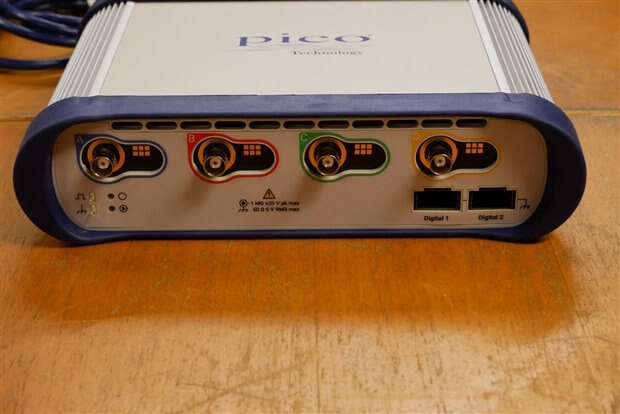
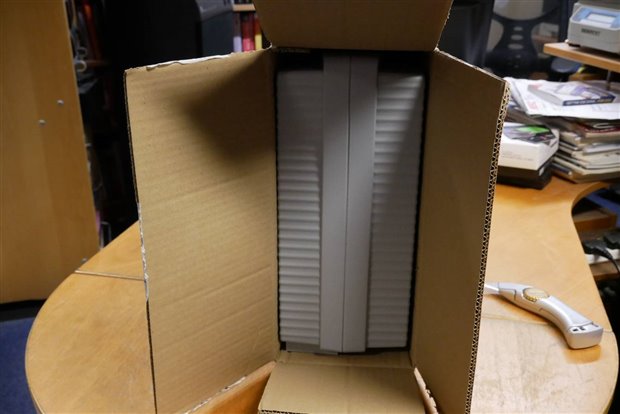
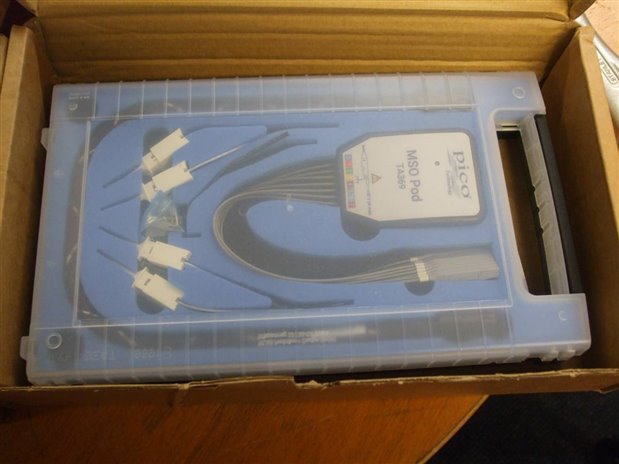

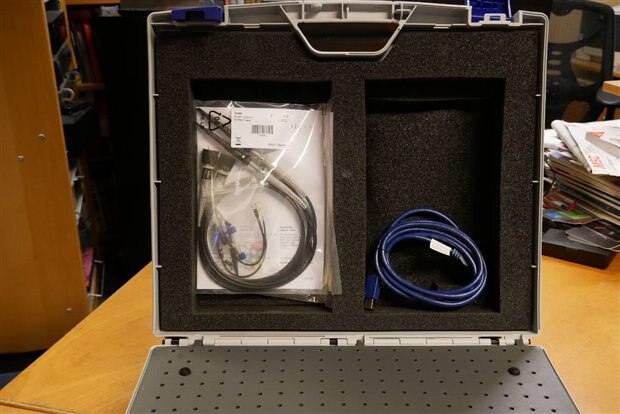
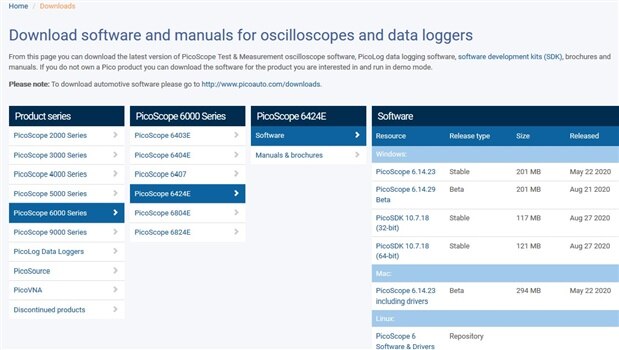

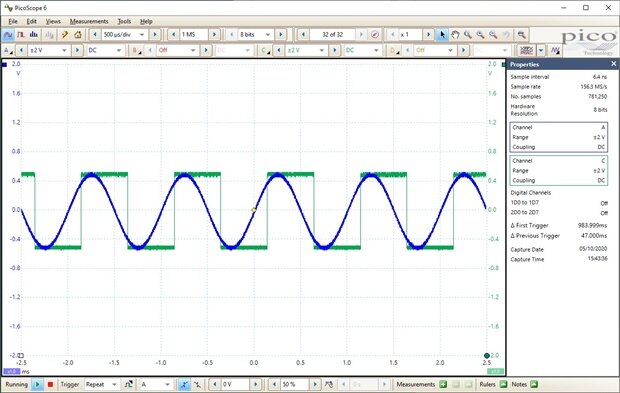
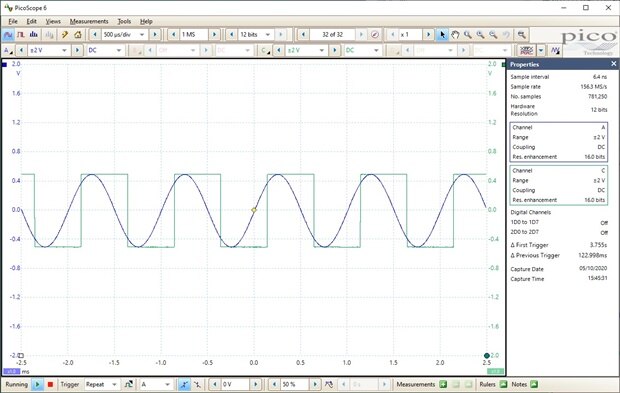

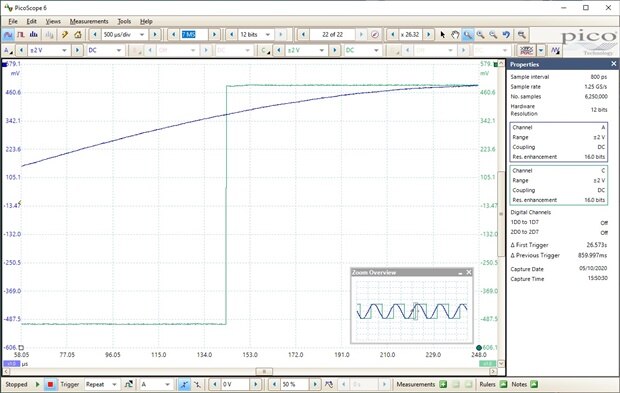
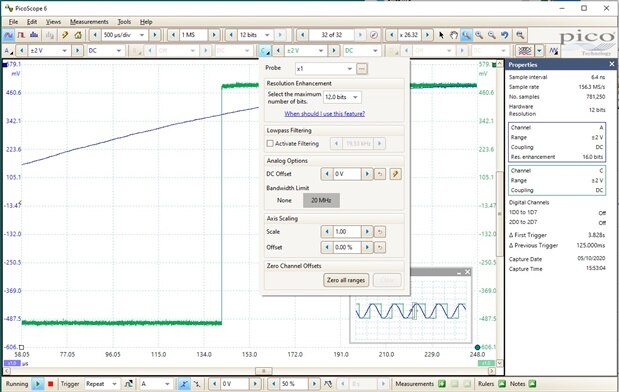
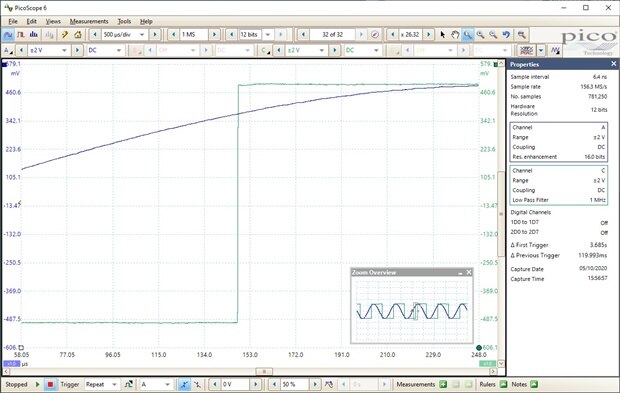
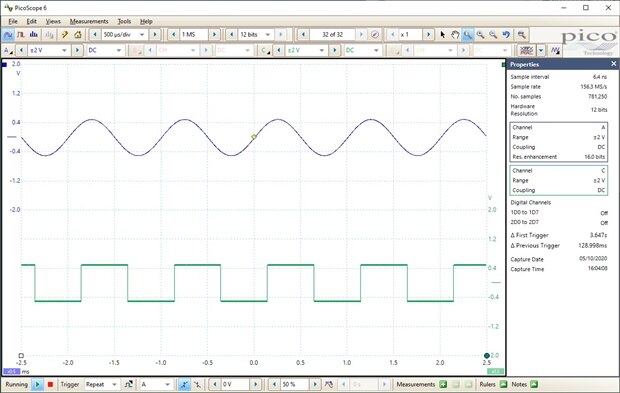
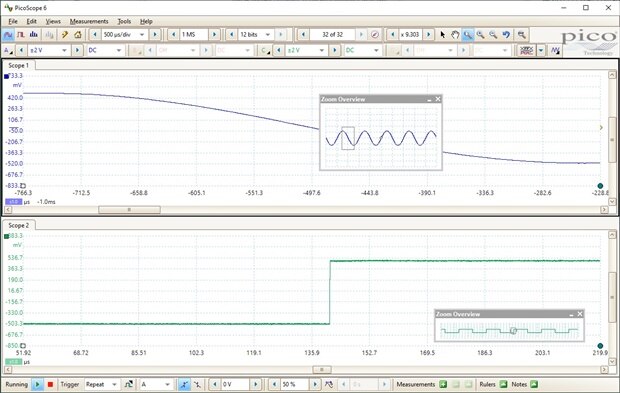
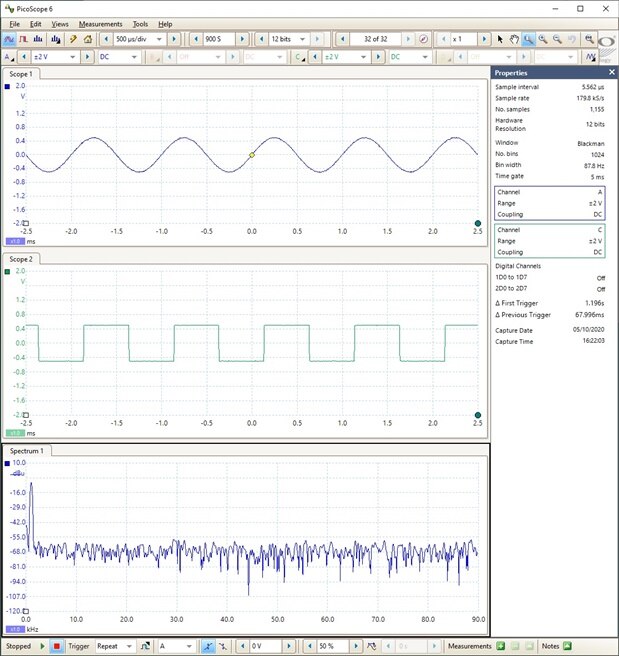
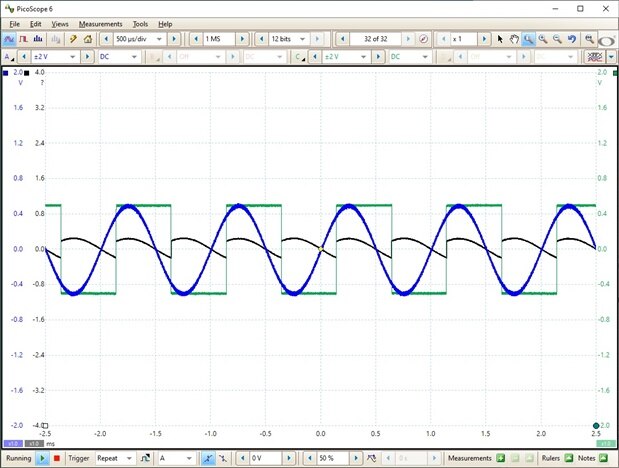
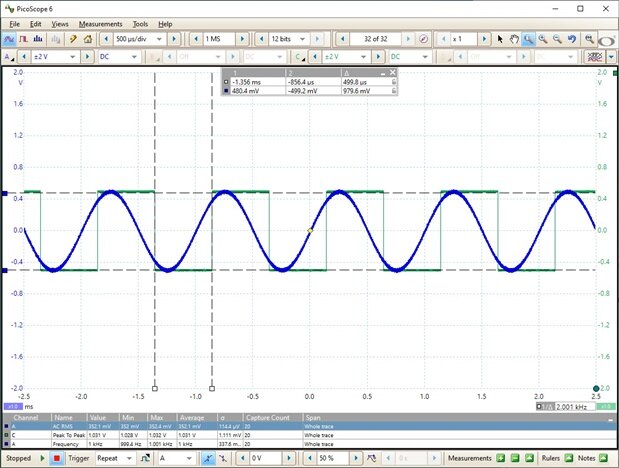
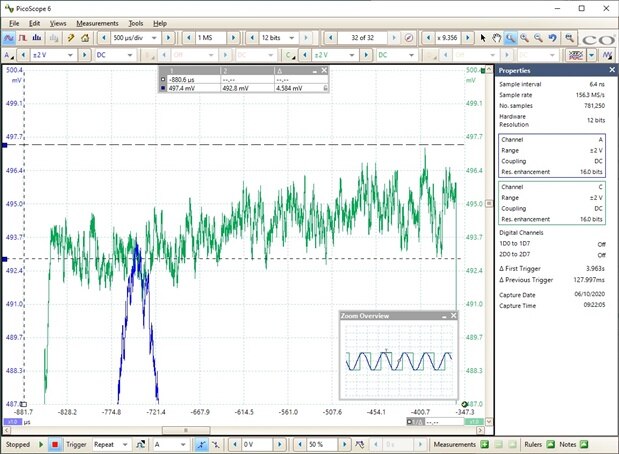
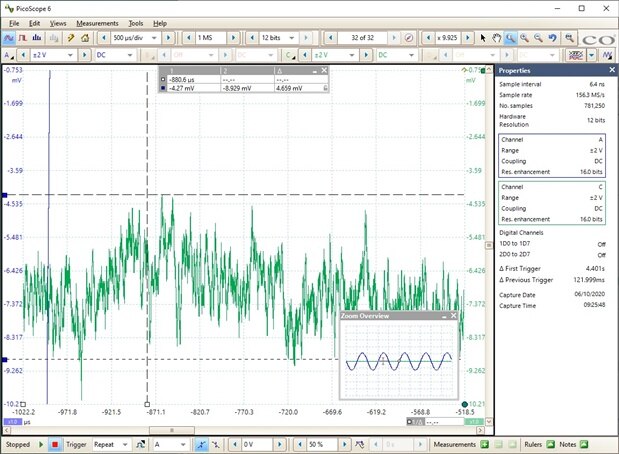
Top Comments